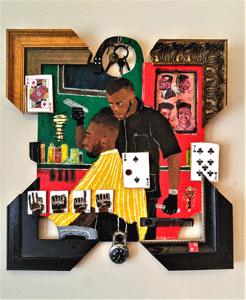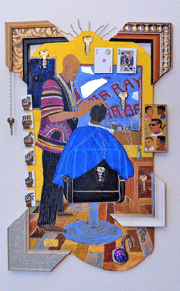Joshua Lee, mental health therapist, facilitator and performance life coach. Owner of UMOJA Integrative Behavioral Health Systems.
After the death of Freddie Gray and the subsequent civil unrest in Baltimore, resulting in rioting, arsons and vandalism in many parts of the city in the spring of 2015, ShopTalk: Share. Heal. Grow., a community-based project was ushered into service.
The project’s mission is to engage the African-American community led by African-American practitioners (including substance abuse professionals, clergy, community empowerment persons, etc.) in discussions that uplift, heal and inspire the community to provide support for each other and begin to solve it’s own problems and challenges, by sharing their own wisdom and knowledge in a safe, supportive environment in barbershops owned by African-Americans.
The African-American barbershop is a community institution, where people gather to have all types of conversations.
ShopTalk: Share. Heal. Grow. employs socio-drama and other action-based techniques to engage members of the community. In their book, Sociodrama: Who’s In Your Shoes?, Sternberg and Garcia state that “Sociodrama is a group action method in which participants act out agreed-upon social situations spontaneously. Sociodrama helps people to express their thoughts and feelings, solve problems, and clarify their values. Rather than simply discussing social issues, sociodrama gets people out of their chairs and exploring in action topics of interest to them.”
“Next Up, Barbershop Series”- Acrylic painting on wood. | Artist: Schroeder Cherry
These facilitated conversations and exercises aim to interact with participants inside of barbershops in order to discuss a number of topics that impact the African-American community, including violence, politics, forgiveness, and drug and alcohol abuse. This format allows the community to experience each other differently and offers solutions to these issues. It’s important to use an action method such as socio-drama in barbershops because of its open environment and no agreement to confidentiality. Sociodrama forms a collective story on a topic that is relevant to the participants. This action structure opens creative outlets for full involvement and self-expression because it is not a 1-person story.
So, how does ShopTalk: Share. Heal. Grow. relate to the Barbershop Art Series by Schroeder Cherry being held at the Function Coworking Community (4709 Harford Rd., Baltimore, MD 21214) on June 9, 2019? I thought it was an excellent chance to engage the wider community, who would appreciate scenes from the barbershop, while at the same time, establish deep connections and have authentic conversations to talk about current events. Additionally, Schroeder Cherry is one of seven finalists for the 2019 Sondheim Artscape Prize. I jumped at the chance to collaborate with my friend of several years when I learned of this current work.
Schroeder Cherry
The intention is to have interactive, highly engaging, conversations with the community inspired by the artwork no matter what one’s background is. Further, Garcia and Sternberg state, “as they explore various issues, they put themselves in other people’s shoes in order to understand themselves and others better. One of the reasons sociodrama works so well is that it taps into the truth about humanity that we are each more alike than we are different. Sociodrama speaks to both sides of the brain, with its action/reflection components. It is a kinesthetic, intuitive, affective and cognitive educational technique. Sociodrama has as its goals: catharsis (expression of feelings), insight (new perception) and role training (behavioral practice).”
Within Schroeder Cherry’s brilliant artwork, there are so many story lines to build upon and play with. For example, when one sees a real combination lock or a set of keys included as part of the artwork, what comes to mind? Who knows? That is the point. We will explore, give voice to and share meaning about the many elements embedded in the artwork together as a community to find out.
The opening event will be curated by L. Nef’fahtiti Partlow-Myrick.
Open to the public. Free admission.



